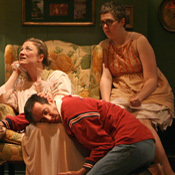
The Sound and the Fury • Press
- The New York Times May 21, 2015
- TimeOut New York January 20, 2015
- Entertainment Weekly May 21, 2015
- Theatermania May 21, 2015
- Exeunt Magazine May 21, 2015
- New York Post May 21, 2015
- New York Daily News May 22, 2015
- Theater Pizzazz! May 21, 2015
- Huffington Post May 21, 2015
- The Bergen Record May 22, 2015
- The Advertiser March 12, 2010
- The Australian March 15, 2010
- Expresso-Actual January 24, 2009
- Publico January 20, 2009
- The New Yorker May 26, 2008
- The New Yorker May 5, 2008
- The New York Times April 30, 2008
- Time Out New York April 30-May 6, 2008
- Time Out New York April 30, 2008
- The New York Sun April 30, 2008
- The International Herald Tribune April 29, 2008
- Variety April 29, 2008
- The New York Times April 27, 2008
- Variety November 30, 2007
- The Brooklyn Rail April 2008
- The Village Voice March 4, 2008
- Variety November 30, 2007
The Sound And The Fury (April Seventh, 1928): Elevator Repair Service At New York Theatre Workshop
by Andy Propst
Putting the first chapter of William Faulkner’s The Sound and the Fury on stage verbatim seems so foolhardy that the concept almost defies credibility. Yet at New York Theatre Workshop, Elevator Repair Service has taken the stream-of-consciousness opening to this modern classic and rendered it as a viable — if not always enjoyable — theatrical offering.
Told from the perspective of Benjy, who is mentally disabled and mute, The Sound and the Fury crisscrosses through some 30 years, from moments when Benjy is just an infant to his adolescent years to his life as an adult. Faulkner’s text is obscure and oblique, and sometimes the temporal shifts in the narrative are so infinitesimal as to disorient the reader. When performed, however, the quick cuts in Benjy’s recollections become abundantly clear: For example, how an event in 1898 becomes one in 1928 is almost instantly apparent on stage — a true triumph.
Equally impressive is the manner in which the 12-person company, under the direction of John Collins, switches between some 27 characters, many played by several of the performers. Although initially confusing, the dual (often gender-bending and colorblind) casting shrewdly mimics the disorientation that Benjy (played almost exclusively by Susie Sokol) experiences in his world. At the same time, this double casting, like other elements of the show, such as dances choreographed by the company and inspired by videos on YouTube, can seem like theatrical caprices that diminish the piece’s power and integrity as it unfolds within the confines of a deliciously detailed and dilapidated living room-dining room set from scenic designer David Zinn.
Upon reflection, though, all the choices in this collaboratively created piece, whether successful or not, are part of an overall design to find the theatrical essence of Faulkner’s work. It’s an ambitious and praiseworthy undertaking that deserves attention and serious contemplation.
View the original article on Backstage’s websitehere .